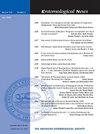以杏仁(Prunus amygdalus Linnaeus)花为食的不同诱捕器捕获的Tropinota hirta(Poda)(鞘翅目:鲸目)的测定
IF 0.4
4区 农林科学
Q4 ENTOMOLOGY
引用次数: 0
摘要
摘要:杏仁(Prunus amygdalus Linnaeus)富含油脂、钙等矿物质,对人体健康非常有益。它被用作新鲜杏仁、坚果干和烤杏仁(加盐或不加盐),也被用于食品行业的糖果、巧克力和糕点行业、杏仁油、化妆品和制药行业,也被用作动物饲料,因为它的绿色果皮含有糖。植物保护因素是影响扁桃生产的不利因素之一。其中一个因素是Tropinota hirta(Poda)(鞘翅目:鲸目)。在世界许多地方,它以商业杏仁园的花朵为食,造成破坏,并被认为是一种重要的经济害虫,因为它会造成产品损失。在本研究中,确定了马尔丁省杏仁园中有害的T.hirta在不同类型的诱捕器中对杏仁生产具有重要潜力和经济意义。这些研究于2018年2月至5月在一个至少有100-150棵树的花园中进行,每周一次。在实验中,研究了漏斗形、盆形、桶形和粘板形信息素和不含信息素的蓝色陷阱类型。在8个不同的诱捕器中进行了13次计数,其中4个含有信息素,4个不含有信息素。在实验中,确定了在信息素陷阱和非信息素陷阱中,汗毛的陷阱数量最多的是漏斗型陷阱,其次是洗衣盆、载水器和蓝色粘片陷阱。该害虫首次出现在大自然中是在3月1日杏仁树开始开花时,当时平均日气温为8-10°C。在3月第二周至4月第二周间,花园的日均温度在13-15°C之间,日均湿度在40-60%之间,害虫的种群密度处于最高水平,在此期间它只以花朵为食。结果表明,随着花期的结束,该害虫的种群密度开始迅速下降,并在5月的第三周结束。本文章由计算机程序翻译,如有差异,请以英文原文为准。
Determination of Tropinota hirta (Poda) (Coleoptera: Cetoniidae) Caught in Different Traps Feeding on Almond (Prunus amygdalus Linnaeus) Flowers
ABSTRACT: Almond (Prunus amygdalus Linnaeus) is very beneficial for human health in terms of high oil, calcium and other mineral substances it contains. It is consumed as fresh almonds, dried nuts, and roasted almonds (with or without salt), as well as in the food industry in the confectionery, chocolate and pastry industries, almond oil, cosmetics and pharmaceutical industries, and also as animal feed because its green peel contains sugar. One of the factors that negatively affect production in almond cultivation is plant protection factors. One of these factors is Tropinota hirta (Poda) (Coleoptera: Cetoniidae). In many parts of the world, it causes damage by feeding on the flowers of the trees in commercial almond orchards and is considered as an economically important pest because it causes product losses. In this study, it was carried out to determine the trapping of T. hirta, which is harmful in almond orchards in Mardin province, has an important potential and economic importance in almond production, in different types of traps. The studies were carried out in a garden with at least 100-150 trees at weekly intervals between February and May in 2018. In the experiments, funnel, basin, bucket and sticky plate-shaped pheromone and blue-colored trap types without pheromones were studied. As a result of 13 counts made in 8 different traps, 4 with pheromone and 4 without pheromone, 6,518 T. hirta were caught. In the experiments, it was determined that in terms of the number of traps of T. hirta in both pheromone and non-pheromone traps, the most in funnel-type traps, followed by washtub, water bearer and blue-colored sticky sheet traps. The first emergence of the pest into nature was the beginning of the phenological flowering of almond trees on March 01, when the daily air temperature was 8-10 °C on average. In the period between the second week of March and the second week of April, where the average daily temperature is between 13-15 °C and the average daily humidity was between 40-60% in the gardens, the population density of the pest was at maximum levels and it only fed on flowers during this period. It was determined that the population density of the pest started to decrease rapidly with the end of the flowering period and ended in the third week of May.
求助全文
通过发布文献求助,成功后即可免费获取论文全文。
去求助
来源期刊

Entomological News
生物-昆虫学
CiteScore
1.10
自引率
25.00%
发文量
17
期刊介绍:
Contributions are accepted on any of the aspects of systematics and taxonomy of insects. This includes: taxonomic revisions, phylogenetics, biogeography and faunistics, and descriptive morphology of insects. Taxonomic papers describing single species are acceptable if such a study is sufficiently justified, however, comprehensive studies that provide a comparative, integrated study of insect systematics and taxonomy will get priority.
 求助内容:
求助内容: 应助结果提醒方式:
应助结果提醒方式:


